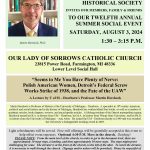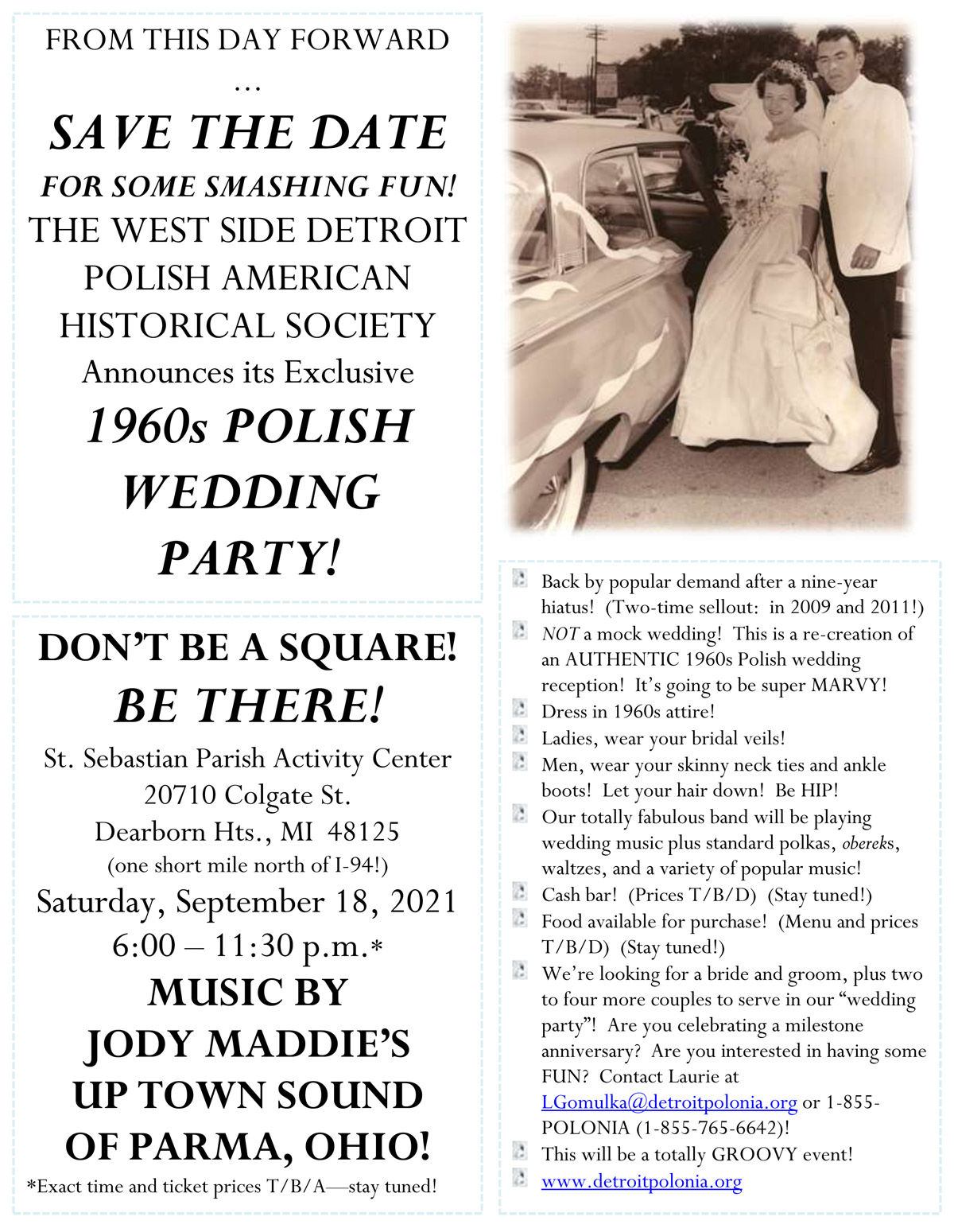WSDPAHS’s Third Annual Summer Social Event:
’60s Polish Wedding Party Jeszcze Raz (“One More Time”)!
Saturday Evening, June 25, 2011
American Legion Carl E. Stitt Post 232 – Dearborn Heights, MI
Was a Smashing Success
By Laurie A. Gomulka
Oh, what a night! The music of Big Daddy Lackowski and His La-De-Da’s Polka Band was the featured highlight of the West Side Detroit Polish American Historical Society’s Third Annual Summer Social Event and just one of the attractions of its second ’60s Polish Wedding Party held on the gorgeous summer evening of June 25, 2011, at the American Legion Carl E. Stitt Post 232 at 23850 Military Road in Dearborn Heights. The event was totally groovy and a smashing success!
Two years ago the Society held its unprecedented ’60s Polish Wedding Party at St. Aidan’s social hall in Livonia, and the event was so popular that the Board decided to bring it back this year by popular demand. There is nothing quite as traditional as a Polish wedding, and during the ’60s weddings were at their peak in the Polish neighborhoods in Detroit. Live polka bands, big Polish dinners, and emphasis on family and revered customs were hallmarks of the wedding receptions. To capture and preserve this part of our heritage, the West Side Detroit Polish American Historical Society decided to recreate one night in the 1960s and to restage a “wedding reception” with a “bride and groom” and bridal party “attendants.”
This year’s bridal party couples were all members of the Society, and all of them were married in the 1960s. They were Joe and Georgia Hawrylak (married August 13, 1960, at St. Christopher Catholic Church in Detroit), Joe and Mary Kay Gromala (married August 14, 1965, at St. Mary’s Catholic Church in Norwalk, Connecticut), John and Mary LaDrigue (married August 21, 1965, at Our Lady of Grace Catholic Church in Dearborn), Mike and Liz Poterala (married February 4, 1961, at Most Holy Redeemer Catholic Church in Detroit), and Don and Chris Unwin (married February 1, 1964, at Our Lady Queen of Angels Catholic Church in Detroit).
There was much emphasis placed on customs and traditions at Polish weddings back in the 1940s, ’50s, and ’60s, and those customs and traditions were carried over to America from Poland. They originated in the Polish countryside and evolved in American cities. These beautiful customs and traditions included the blessing of the bride in the home as she knelt before her mother and received her mother’s benediction as a live band performed the traditional Serdeczna Matko, or “Dearest Mother.” As the bride then emerged from the home onto the porch, the band performed the traditional Polish Wedding March, Troska Porodina (“Longing for Home”), also known as Marsz Weselny. This is a Ukrainian march and has come to be known as both the “Ukrainian Wedding March” and the “Polish Wedding March.” Over the years, the title became Anglicized by Polish Americans as Na Porciu (“On the Porch”).
The band also played the Polish national anthem as the bride emerged. This was a signal to the entire neighborhood that there was a Polish wedding taking place in the neighborhood, and it was not uncommon for neighbors to emerge from their surrounding homes at this time and to stand in reverence with their hands over their hearts as the anthem was played.
When the bride and groom entered the reception hall, the band performed the traditional Po Ślubie (“After the Ceremony”), also known as Po Weselu (“After the Wedding”). At this time, it was not uncommon for wedding reception attendees to insert dollar bills into the F-holes of the stand-up string bass as they entered the hall, which later were shaken out and divided up among the musicians.
As the bridal party entered the hall, the cook came from the kitchen with a tray containing bread and salt, with which she would bless the bridal party. The traditional blessing, “Aby Wam go nigdy nie brakowało!” (“May you never be without”) was proclaimed by the parents.
At the Society’s ’60s Polish Wedding Party, these customs were recreated. Once everyone had arrived, the “bridal party” was escorted out of the hall and then led back in as Big Daddy and His La-De-Da Orchestra performed the traditional Polish Wedding March. The blessing with bread and salt was then recreated and the “bridal party” took their seats at the head table.
Msgr. Stanley Milewski, Chancellor-Emeritus of the Orchard Lake Schools and a WSDPAHS member, blessed the “newlyweds” and wished them many long years of happiness together, much to the delight and stifled laughter of the wedding party guests. He then blessed the food and all enjoyed a meal prepared by Halina, our cook, that consisted of chicken noodle soup (rosół), another long-standing tradition of Polish-American weddings, stuffed cabbage (gołąbki), city chicken (patyczki), chicken (kurczak), green salad with ranch and Italian dressing (sałatka), cole slaw, green beans with mushrooms (fasola i grzyby), mashed potatoes & gravy (źiemniaki i sos), au gratin potatoes (źiemniaki i ser), sauerkraut (kapusta), bread & butter (chleb i mazło), and wedding cake (kolacz Weselny).
Music and dancing continued throughout the evening and at 9:00 we held the “Grand March” and Oczepiny (“Unveiling”). The Grand March traditionally was led by the orchestra leader and took place at midnight. It signified a new day, when the bride and groom became man and wife. During the performance of Oczepiny, the bride’s veil was ceremoniously removed by one of the bridesmaids and it was passed to each bridesmaid to wear on her head as she danced with her partner for a few measures of dancing.
Typical numbers played during a 1960s wedding reception were Jak Szybko Mijają Chwile (“How Quickly Time Passes”), “Daddy’s Little Girl,” Tatusiu (“Daddy’s”) Waltz, “Let Me Call You Sweetheart,” and “Anniversary Waltz.” Big Daddy’s trumpet player Jack Wolak did a fabulous job leading the Grand March, and everyone had a blast forming a chain that wound throughout the reception hall. Later, Big Daddy led everyone in the traditional “Chicken Dance,” which progressively got faster and faster and was hilarious!
This year’s ’60s Polish Wedding Party committee included Laurie A. Gomulka, Bob Bielenda, Alina Klin, Ph.D., Adam R. Lis, Rev. Gary Michalik, Aleksandra (Sandy) Porter, Rev. Walter Ptak, Pamela Rupinski, Leonard Skowronski, and Richard Sokolowski. Cakes were provided by Sisters Cakery on West Warren Ave. in Detroit. Special thanks are extended to Esther Dasin, aunt of Mary LaDrigue, who hand-made the bridesmaids’ headpieces; to Mary LaDrigue, who helped with all the table favors; to Larry Choraszewski, who helped with the hall set-up; to Mike Poterala, who helped promote our event; to Msgr. Stanley E. Milewski; to Chuck Roeske of Stitt Post; and to Halina and family for the wonderful meal. The Society also thanks our friends, patrons and advertisers who supported us by sponsoring our event with ads in our program.
The Society is grateful to all who put forth an effort to make this year’s event the success that it was, and we look forward to our next “totally” social event!


